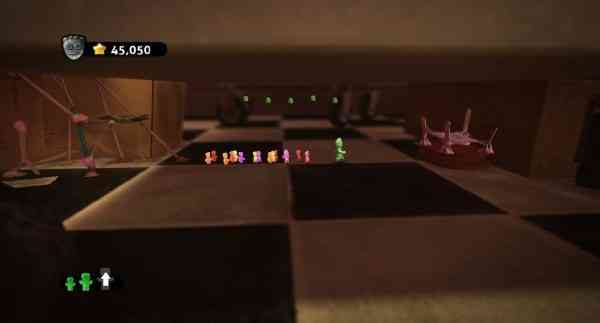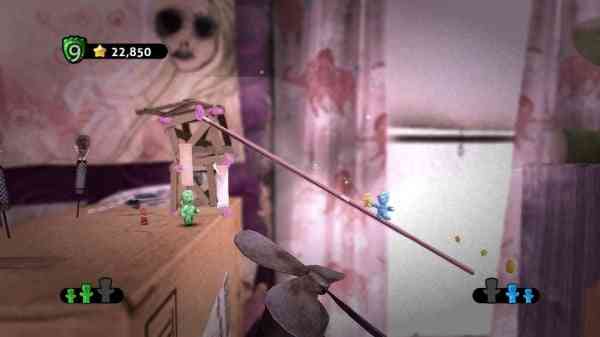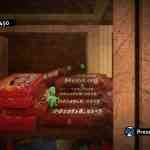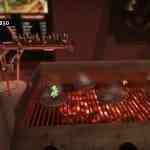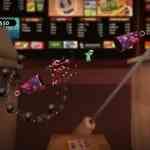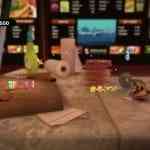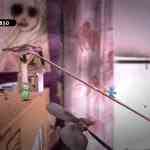Those delicious and individually colored candy treats known as Sour Patch Kids are now the stars of a downloadable video game from Playbrains and Capcom entitled World Gone Sour. This five-dollar release borrows some mechanics from both recent and old school platformers and makes for a game that many may just want to try.
World Gone Sour’s story is unique and unusual. Its profound narrative tells the story of a single green sour patch kid who has tragically fallen into a garbage can during a failed attempt at being eaten. Having lost his best friend in a factory mishap, this chewable candy piece decides to venture out of the trash-filled trap in an attempt to find a human’s belly. The story stresses the importance of the pilgrimage that these globs of sugar must complete. Apparently they desire nothing more than to fight their way into your mouth and sacrifice themselves to your hunger. Surprisingly, Playbrains proves that it is possible to pull an adequate platformer out of this bizarre concept. By playing through three different worlds, each consisting of three lengthy stages, and some occasional boss battles, you’ll learn more and more about the life of a Sour Patch Kid. Although some elements of its mechanics might be flawed, World Gone Sour manages to hit a sweet spot that most fans of the platforming genre should enjoy.
The controls in World Gone Sour are quite intuitive and simple. Anyone who has ever played a generic platforming game will be able to pick up and play this game with no difficulties. Running, jumping and fighting are all standard platforming fare and it’s all pretty solid. Fighting is extremely similar to Mario’s combat where you must leap upon an enemy’s head to defeat them. The controls, while good, aren’t quite as responsive or as smooth as I would have liked them to be. I found that some of the techniques that become important later in the game — especially wall jumping and using grappling hooks — proved to be frustratingly fickle and unresponsive. These issues naturally drop the gameplay down a peg, as controls in a platformer are incredibly important. These control issues really stand out in the last world our green Sour Patch Kid visits. Traps are found everywhere and I was constantly dying while wondering why my character wasn’t wall jumping properly even though I was executing the command correctly.
As previously stated, gameplay consists of the typical mechanics you find in any side-scrolling action-platformer. Your little gummy character can jump and use a variety of special moves. Some unique elements involve recruiting other little ‘sour kids’ as he pursues his quest. With more followers your candy protagonist is able to buff himself up into bigger, more robust sizes, giving him new and exclusive moves. Consuming your friends as you find them will make you bigger, able to withstand more damage, and will allow you to execute special moves, such as ground pounding through weakened floors or tossing energized candies at armored enemies.
While the smallest version of your character is spry and agile, he can also be killed in one hit. I was caught off guard by World Gone Sour’s very dark approach to humor. Both your character and your companions can be killed in any number of ways, and the game encourages it. Along with finding point-increasing stars, scouring for hidden collectibles, and killing enemies, you can increase your score by destroying your friends. I discovered that making these sacrifices became integral to progressing in the game.
Stage attempts are rated after clearing a mission. Using a points system that combines all the stars you collect, enemies you kill, allies you save and collectibles you discover, the game rates your performance. The resulting total is posted on stage-specific leaderboards, with an accumulated total being your collective campaign score. This system provides a fun way to challenge friends, as there’s a lack of competitive or online multiplayer to be found in the game, although local co-op is available.
Playing as a candy-based character means that the world must be scaled according to how tiny the candy characters are. Playbrains scaled the environments smoothly and appropriately, creating some relatively creative and enjoyable levels. The very first stage has you attempting to find a way out of a garbage can. Such a simple concept becomes an entire world for you to explore, and I thought this was neat. The majority of the locations visited are filled with clutter, but this clutter is necessary to support the level design. Working through a tidy room where there is nothing to avoid or hurdle over would make for a boring gameplay experience.
Something that really surprised me was that this game had a lot of loading times. A startling abundance of lengthy load times were encountered in my time with World Gone Sour. For a small digital game running off my 360’s hard drive, I couldn’t believe the length of time it took to transition between stages and menus.
World Gone Sour is not a visually impressive game by any means, but it doesn’t look horrible either. The included environments show quite a bit of detail, and it is clear that thought was put into turning discovered items into comical jokes. As a minor quibble, I did notice a lack of exciting alternative environments and felt that the game could have used some more visual variety. Although each level is populated by lots of items and objects to jump over or run around, the variety was lacking in terms of the total number of environments.
The voice acting is solid and works well for World Gone Sour’s overall style. Creed Bratton of The Office provides narration through the entire game. His inclusion certainly adds a lot to the character of the game even though the script was less than brilliant. The tunes playing in the background are in step with the peculiar and morbid action that is showcased, as well as the game’s overall presentation style. That being said, sound effects can get a bit repetitive and the music, while functional, isn’t all that memorable.
I must admit that I was initially disappointed by World Gone Sour’s technical faults; however, as I spent more time with the title its dark humor and quirky charm began to win me over. With an asking price of only five dollars, World Gone Sour is a reasonably priced platformer containing a quirky premise and mildly amusing gameplay mechanics. Fans of old-school platformers may want to check this one out, especially considering the affordable price point, but be forewarned, the experience is not a perfect one, as the game is troubled by mechanical issues, long loading times and a lack of replay value. Despite these problems, there is some fun to be had in this odd little title.
